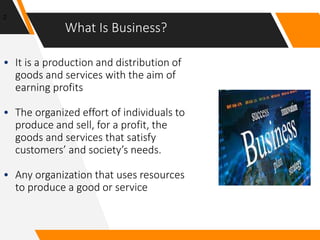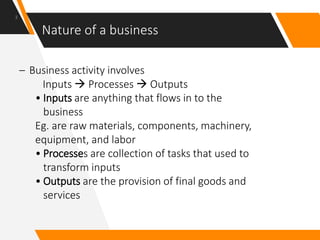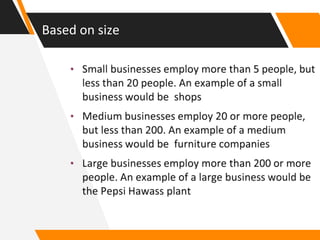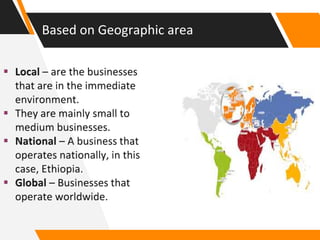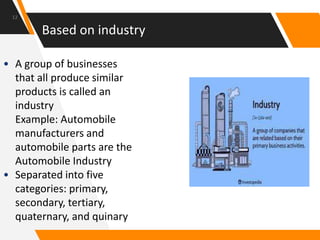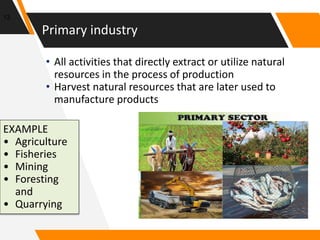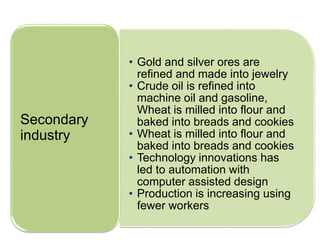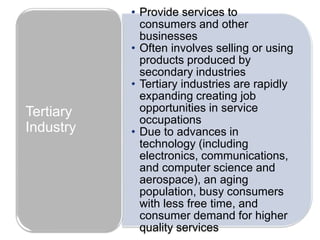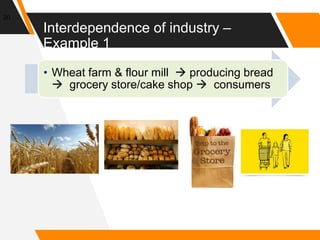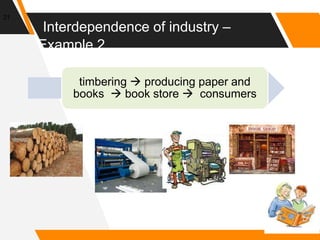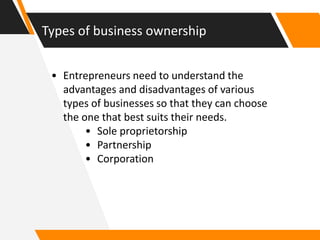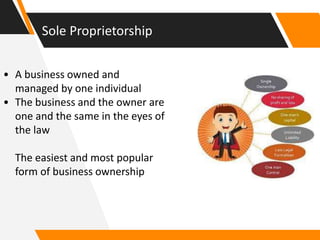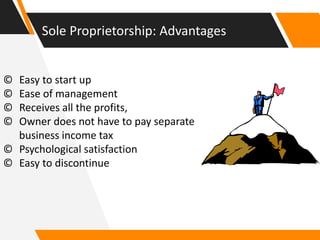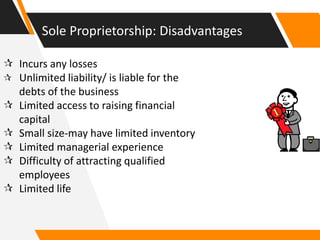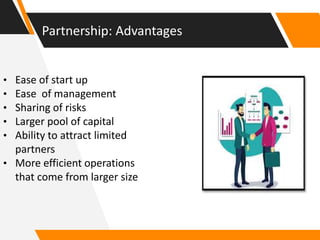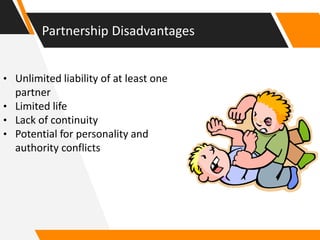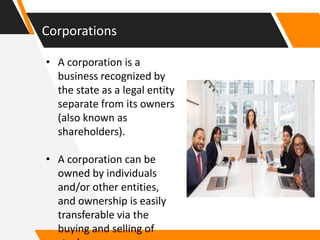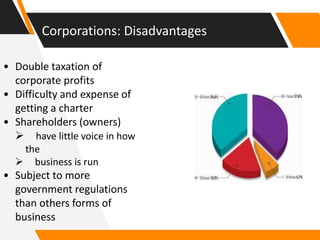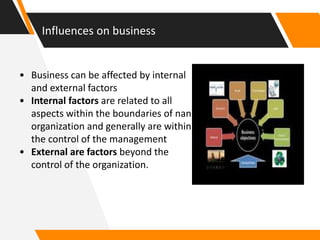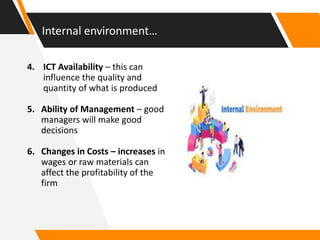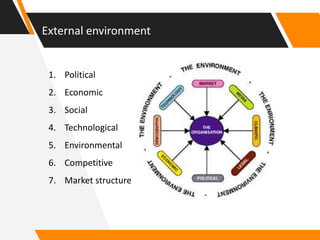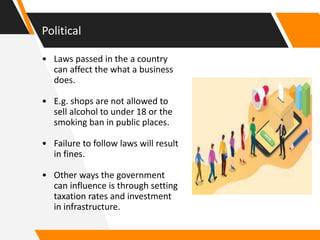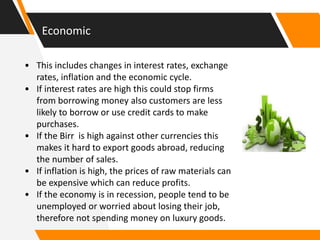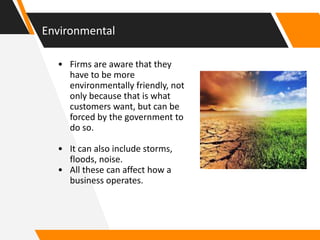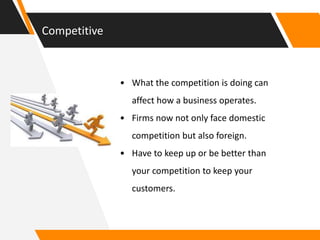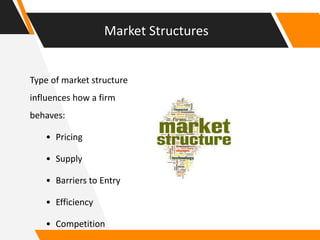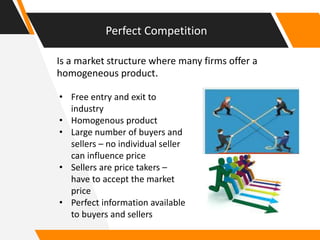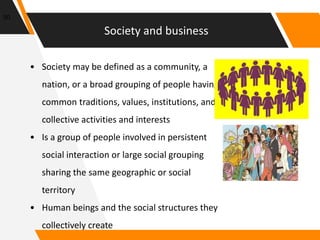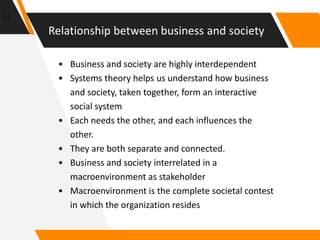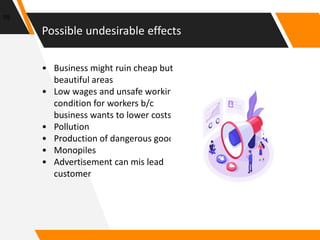BS chapter 1.pptx
- 1. OVERVIEW OF BUSINESS AND SOCIETY CHAPTER ONE
- 2. What Is Business? 2 • It is a production and distribution of goods and services with the aim of earning profits • The organized effort of individuals to produce and sell, for a profit, the goods and services that satisfy customers’ and society’s needs. • Any organization that uses resources to produce a good or service
- 3. Nature of a business 3 – Business activity involves Inputs Processes Outputs • Inputs are anything that flows in to the business Eg. are raw materials, components, machinery, equipment, and labor • Processes are collection of tasks that used to transform inputs • Outputs are the provision of final goods and services
- 4. Inputs • Land and natural resources include fields to build factories on; energy to power factory • Labor includes employees needed to operate machines, sell to customers • Capital includes plant and machinery, computers, finance • Entrepreneurs are People who are prepared to invest in and manage a business 4
- 5. Products – Product = anything that satisfies customer needs and wants. This can be: – A “good” • Something tangible • E.g. a mobile phone – A “service” • Usually intangible • Something other people do for you • E.g. the service you receive when you stay in a hotel
- 6. Types of goods 6 – Consumer goods: are sold to the general public and can be durable or non-durable. –Durable goods: consumer goods that can be used over time, repeatedly. – Examples: televisions, t- shirts, books, cars – Non-durable goods: are consumer goods that can only be used once. – Examples: food, drinks, and candy
- 7. Continued.. • Capital Goods: are used by industry to produce other goods and services • Examples: machinery, cranes, dump trucks • Consumer Service: Non- tangible product that sold to the consumer • Examples: hotel rooms, airplane tickets, insurance 7
- 8. Role and importance of Business 8 • Providing employment opportunities • Satisfying consumers’ needs and wants by producing goods and providing services • Generating income for people and the government • Promoting economic growth and raising people’s living standard
- 9. Classification of Business 9 Common classifications are: • Based on size • Based on geographic area • Based on industry • Based on ownership
- 10. Based on size
- 11. Based on Geographic area
- 12. Based on industry 12 • A group of businesses that all produce similar products is called an industry Example: Automobile manufacturers and automobile parts are the Automobile Industry • Separated into five categories: primary, secondary, tertiary, quaternary, and quinary
- 13. Primary industry 13 EXAMPLE • Agriculture • Fisheries • Mining • Foresting and • Quarrying • All activities that directly extract or utilize natural resources in the process of production • Harvest natural resources that are later used to manufacture products
- 14. Secondary Industry 14 EXAMPLE • Manufacturing • Construction; and • The supply of electricity, gas, and water • All processes of turning raw materials into finished goods or semi-finished goods • Manufacture raw materials into finished products
- 15. Industry • Gold and silver ores are refined and made into jewelry • Crude oil is refined into machine oil and gasoline, Wheat is milled into flour and baked into breads and cookies • Wheat is milled into flour and baked into breads and cookies • Technology innovations has led to automation with computer assisted design • Production is increasing using fewer workers Secondary industry
- 16. Tertiary industry 16 EXAMPLE wholesale, retail, and import/export trade; restaurants and hotels; transport, storage, and communications; financing, insurance, real estate, and business services • All economic activities that provide services to business and consumers
- 17. • Provide services to consumers and other businesses • Often involves selling or using products produced by secondary industries • Tertiary industries are rapidly expanding creating job opportunities in service occupations • Due to advances in technology (including electronics, communications, and computer science and aerospace), an aging population, busy consumers with less free time, and consumer demand for higher quality services Tertiary Industry
- 18. Quaternary industry • Are tertiary sector but with a focus on information processing. • It emphasizes technology, intellectual activities, processing of symbols or symbolic objects such as information, numbers, words, or money. • This industry has largely grown. • Typical examples of quaternary businesses include banks, insurance businesses, media, researchers, politicians
- 19. Quinary Industry • The quinary industry, like the quaternary sector, provides services. • Businesses in the quinary industry provide services such as education and health care • It includes also non-profit organizations such as the army and government organizations such as health, education, and police.
- 20. 20 • Wheat farm & flour mill producing bread grocery store/cake shop consumers Interdependence of industry – Example 1
- 21. 21 timbering producing paper and books book store consumers Interdependence of industry – Example 2
- 22. Types of business ownership • Entrepreneurs need to understand the advantages and disadvantages of various types of businesses so that they can choose the one that best suits their needs. • Sole proprietorship • Partnership • Corporation
- 23. Sole Proprietorship • A business owned and managed by one individual • The business and the owner are one and the same in the eyes of the law The easiest and most popular form of business ownership
- 24. Sole Proprietorship: Advantages © Easy to start up © Ease of management © Receives all the profits, © Owner does not have to pay separate business income tax © Psychological satisfaction © Easy to discontinue
- 25. Sole Proprietorship: Disadvantages Incurs any losses Unlimited liability/ is liable for the debts of the business Limited access to raising financial capital Small size-may have limited inventory Limited managerial experience Difficulty of attracting qualified employees Limited life
- 26. Partnership An association of two or more people who co-own a business for the purpose of making a profit
- 27. Types of Partnership General vs Limited The law requires that all partnerships have at least one general partner. A partnership may be set up so that all of the partners are general partners. General partner A participant in a partnership who has unlimited personal liability and takes full responsibility for managing the business
- 28. Partnership types • Some partnerships include a limited partner. Limited partner A partner in a business whose liability is limited to his or her investment; a limited partner cannot be actively involved in managing the business
- 29. Partnership: Advantages • Ease of start up • Ease of management • Sharing of risks • Larger pool of capital • Ability to attract limited partners • More efficient operations that come from larger size
- 30. Partnership Disadvantages • Unlimited liability of at least one partner • Limited life • Lack of continuity • Potential for personality and authority conflicts
- 31. Corporations • A corporation is a business recognized by the state as a legal entity separate from its owners (also known as shareholders). • A corporation can be owned by individuals and/or other entities, and ownership is easily transferable via the buying and selling of
- 32. Corporations: Advantages • Ease of raising financial capital • Limited liability for its owners • Board of directors can hire professional managers to run the firm • Unlimited life • Ease of transferring ownership of the corporation
- 33. Corporations: Disadvantages • Double taxation of corporate profits • Difficulty and expense of getting a charter • Shareholders (owners) have little voice in how the business is run • Subject to more government regulations than others forms of business
- 34. Influences on business • Business can be affected by internal and external factors • Internal factors are related to all aspects within the boundaries of nan organization and generally are within the control of the management • External are factors beyond the control of the organization.
- 35. Internal environment These are factors from inside the firm that could affect performance. 1. Finance available – without money the firm may not be able to do what they wish. 2. Ability of staff – the more capable staff are the more productive they will be 3. Information available – the better the information the better the decisions made.
- 36. Internal environment… 4. ICT Availability – this can influence the quality and quantity of what is produced 5. Ability of Management – good managers will make good decisions 6. Changes in Costs – increases in wages or raw materials can affect the profitability of the firm
- 37. External environment 1. Political 2. Economic 3. Social 4. Technological 5. Environmental 6. Competitive 7. Market structure
- 38. Political • Laws passed in the a country can affect the what a business does. • E.g. shops are not allowed to sell alcohol to under 18 or the smoking ban in public places. • Failure to follow laws will result in fines. • Other ways the government can influence is through setting taxation rates and investment in infrastructure.
- 39. Economic • This includes changes in interest rates, exchange rates, inflation and the economic cycle. • If interest rates are high this could stop firms from borrowing money also customers are less likely to borrow or use credit cards to make purchases. • If the Birr is high against other currencies this makes it hard to export goods abroad, reducing the number of sales. • If inflation is high, the prices of raw materials can be expensive which can reduce profits. • If the economy is in recession, people tend to be unemployed or worried about losing their job, therefore not spending money on luxury goods.
- 40. Social Demographic changes • This is to do with the size and distribution of the population of a country. • E.g. if a country has an ageing population, this has led to a rise in products aimed at older people and firms recruiting older workers
- 41. Social… Socio-cultural changes • This is about changes in lifestyle and attitude. E.g. More women working has seen a rise in ready meal and later opening hours • More concern about the environment, forcing firms to maybe use recycled products. • People have more leisure time, changes in attitude to single mothers have also affected the types of products offered.
- 42. Technological • Firms need to keep up-to-date with the latest technology in order to remain competitive. • Have seen a huge growth in e- commerce (buying and selling online) • Use of machinery in the production process – more efficient and cheaper.
- 43. Environmental • Firms are aware that they have to be more environmentally friendly, not only because that is what customers want, but can be forced by the government to do so. • It can also include storms, floods, noise. • All these can affect how a business operates.
- 44. Competitive • What the competition is doing can affect how a business operates. • Firms now not only face domestic competition but also foreign. • Have to keep up or be better than your competition to keep your customers.
- 45. Market Structures Type of market structure influences how a firm behaves: • Pricing • Supply • Barriers to Entry • Efficiency • Competition
- 46. Market Structure • Determinants of market structure – Freedom of entry and exit – Nature of the product – homogenous (identical), differentiated? – Control over supply/output – Control over price – Barriers to entry
- 47. Perfect Competition • Free entry and exit to industry • Homogenous product • Large number of buyers and sellers – no individual seller can influence price • Sellers are price takers – have to accept the market price • Perfect information available to buyers and sellers Is a market structure where many firms offer a homogeneous product.
- 48. Imperfect /monopolistic competition • Many buyers and sellers • Products differentiated • Relatively free entry and exit • Each firm may have a tiny ‘monopoly’ because of the differentiation of their product • Firm has some control over price Examples – restaurants, building firms – plasterers, plumbers, etc. Is a type of market structure where many companies are present in an industry, and they produce similar but differentiated products
- 49. Oligopoly – competition amongst the few • Industry dominated by small number of large firms • High barriers to entry • Products could be highly differentiated • Non–price competition • Price stability within the market • Potential for collusion • Abnormal profits • High degree of interdependence between firms Is a market structure with few firms and barriers to entry.
- 50. Society and business 50 • Society may be defined as a community, a nation, or a broad grouping of people having common traditions, values, institutions, and collective activities and interests • Is a group of people involved in persistent social interaction or large social grouping sharing the same geographic or social territory • Human beings and the social structures they collectively create
- 51. Relationship between business and society 51 • Business and society are highly interdependent • Systems theory helps us understand how business and society, taken together, form an interactive social system • Each needs the other, and each influences the other. • They are both separate and connected. • Business and society interrelated in a macroenvironment as stakeholder • Macroenvironment is the complete societal contest in which the organization resides
- 52. Society as the macroenvironment 52 Four segments of the macroenvironments 1. Social environment: focus on demographic, lifestyle and social values 2. Economic environment: focus on the economy 3. Political environment: focus on the legislative process, election process and the interaction between firms, politics and government 4. Technological environment: focus on the changes in technological advancement.
- 53. The impacts of business activities on society 53 • All business activity has benefits and undesirable effects on society • These reasons are why governments want to have some control over the business activities • Governments tent to pass laws that restrict undesirable activities while supporting
- 54. Possible benefits of business 54 • Production of useful goods to satisfy customers wants • Create employment • Increase workers living standards • Introduction of new products or process that reduces costs and widen product range • Taxes help to finance public services • Business can earn foreign currency in exports and this could be spent on imports
- 55. Possible undesirable effects 55 • Business might ruin cheap but beautiful areas • Low wages and unsafe working condition for workers b/c business wants to lower costs • Pollution • Production of dangerous goods • Monopiles • Advertisement can mis lead customer

